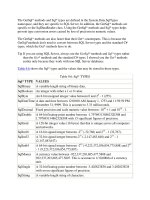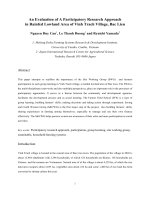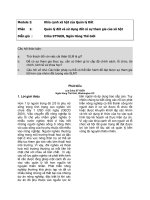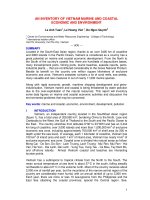Tài liệu AN OVERVIEW OF RECENT DEVELOPMENTS IN NANOTECHNOLOGY pptx
Bạn đang xem bản rút gọn của tài liệu. Xem và tải ngay bản đầy đủ của tài liệu tại đây (10.47 MB, 51 trang )
M. Meyyappan
Director, Center for Nanotechnology
NASA Ames Research Center
Moffett Field, CA 94035
web:
• Advanced miniaturization, a key thrust area to enable new science and
exploration missions
- Ultrasmall sensors, power sources, communication, navigation,
and propulsion systems with very low mass, volume and power
consumption are needed
• Revolutions in electronics and computing will allow reconfigurable,
autonomous, “thinking” spacecraft
• Nanotechnology presents a whole new
spectrum of opportunities to build
device components and systems for
entirely new space architectures
- Networks of ultrasmall
probes on planetary surfaces
- Micro-rovers that drive,
hop, fly, and burrow
- Collection of microspacecraft
making a variety of measurements
Europa Submarine
* Carbon Nanotubes
• Growth (CVD, PECVD)
• Characterization
• AFM tips
- Metrology
- Imaging of Mars Analog
- Imaging Bio samples
• Electrode development
• Biosensor (cancer diagnostics)
• Chemical sensor
• Logic Circuits
• Chemical functionalization
• Gas Absorption
• Device Fabrication
* Molecular Electronics
• Synthesis of organic molecules
• Characterization
• Device fabrication
* Inorganic Nanowires
* Protein Nanotubes
• Synthesis
• Purification
• Application Development
*Genomics
• Nanopores in gene sequencing
• Genechips development
* Computational Nanotechnology
• CNT - Mechanical, thermal properties
• CNT - Electronic properties
• CNT based devices: physics, design
• CNT based composites, BN nanotubes
• CNT based sensors
• DNA transport
• Transport in nanopores
• Nanowires: transport, thermoelectric effect
• Transport: molecular electronics
• Protein nanotube chemistry
* Quantum Computing
* Computational Quantum Electronics
• Noneq. Green’s Function based Device Simulator
* Computational Optoelectronics
* Computational Process Modeling
• Nanoelectronics (CNTs, molecular electronics)
• Non-CMOS circuits and architectures, reconfigurable systems
• Spintronics, quantum computing, nanomagnetics
• Nanophotonics, nano-optics, nanoscale lasers….
• Chemical and biological sensors
• Novel materials for all applications (CNTs, quantum dots,
inorganic nanowires…
• Integration of nano-micro-macro
• Bio-nano fusion
•
•
•
• Carbon Nanotubes
- CNT - growth and characterization
- CNT based nanoelectronics
- CNT based microscopy
- CNT interconnects
- CNT based biosensors
- CNT chemical sensors
• Some other Nano examples
- Inorganic nanowires
-Protein nanotubes
- Nano in gene sequencing
CNT is a tubular form of carbon with diameter as small as 1 nm.
Length: few nm to microns.
CNT is configurationally equivalent to a two dimensional graphene
sheet rolled into a tube.
CNT exhibits extraordinary mechanical
properties: Young’s modulus over
1 Tera Pascal, as stiff as diamond, and tensile
strength ~ 200 GPa.
CNT can be metallic or semiconducting,
depending on chirality.
• The strongest and most flexible molecular
material because of C-C covalent bonding
and seamless hexagonal network architecture
• Young’s modulus of over 1 TPa vs 70 GPa for
Aluminum, 700 GPA for C-fiber
- strength to weight ratio 500 time > for Al;
similar improvements over steel and
titanium; one order of magnitude
improvement over graphite/epoxy
• Maximum strain ~10% much higher than any
material
• Thermal conductivity ~ 3000 W/mK in the axial
direction with small values in the radial direction
• Electrical conductivity six orders of magnitude higher than copper
• Can be metallic or semiconducting depending on chirality
- ‘tunable’ bandgap
- electronic properties can be tailored through application of
external magnetic field, application of mechanical
deformation…
• Very high current carrying capacity
• Excellent field emitter; high aspect ratio
and small tip radius of curvature are
ideal for field emission
• Can be functionalized
• CNT quantum wire interconnects
• Diodes and transistors for
computing
• Capacitors
• Data Storage
• Field emitters for instrumentation
• Flat panel displays
• THz oscillators
Challenges
• Control of diameter, chirality
• Doping, contacts
• Novel architectures (not CMOS based!)
• Development of inexpensive manufacturing processes
• High strength composites
• Cables, tethers, beams
• Multifunctional materials
• Functionalize and use as polymer back bone
- plastics with enhanced properties like “blow
molded steel”
• Heat exchangers, radiators, thermal barriers, cryotanks
• Radiation shielding
• Filter membranes, supports
• Body armor, space suits
Challenges
- Control of properties, characterization
- Dispersion of CNT homogeneously in host materials
- Large scale production
- Application development
• CNT based microscopy: AFM, STM…
• Nanotube sensors: force, pressure, chemical…
• Biosensors
• Molecular gears, motors, actuators
• Batteries, Fuel Cells: H
2
, Li storage
• Nanoscale reactors, ion channels
• Biomedical
- in vivo real time crew health monitoring
- Lab on a chip
- Drug delivery
- DNA sequencing
- Artificial muscles, bone replacement,
bionic eye, ear
Challenges
• Controlled growth
• Functionalization with
probe molecules, robustness
• Integration, signal processing
• Fabrication techniques
• CNT has been grown by laser ablation
(pioneering at Rice) and carbon arc process
(NEC, Japan) - early 90s.
- SWNT, high purity, purification methods
• CVD is ideal for patterned growth
(electronics, sensor applications)
- Well known technique from
microelectronics
- Hydrocarbon feedstock
- Growth needs catalyst
(transition metal)
- Multiwall tubes at
500-800° deg. C.
- Numerous parameters
influence CNT growth
- Surface masked by a 400 mesh TEM grid
- Methane, 900° C, 10 nm Al/1.0 nm Fe/0.2 nm Mo
-Surface masked by a 400 mesh TEM grid; 20 nm
Al/ 10 nm Fe; nanotubes grown for 10 minutes
Grown using ethylene at 75
0
o
C
• Inductively coupled plasmas are the simplest type of plasmas; very efficient in sustaining
the plasma; reactor easy to build and simple to operate
• Quartz chamber 10 cm in diameter with a window for sample introduction
• Inductive coil on the upper electrode
• 13.56 MHz independent capacitive power on the bottom electrode
• Heating stage for the bottom electrode
• Operating conditions
CH
4
/H
2
: 5 - 20%
Total flow : 100 sccm
Pressure : 1 - 20 Torr
Inductive power : 100-200 W
Bottom electrode power : 0 - 100 W
*First single nanotube logic device — Inverter demonstration (Appl. Phys. Lett., Nov. 200
by Chongwu Zhou (USC) and Jie Han (NASA Ames)
2.5
2.0
1.5
1.0
0.5
0.0
V
out
(V)
2.52.01.51.00.50.0
V
in
(V)
V
DD
=2.9 V
V
i
n
V
ou
t
0
V
V
DD
p
n
100
80
60
40
20
0
I
DS
(nA)
-20 -15 -10 -5 0
V
g
(V)
V
DS
=10 mV
12
8
4
0
DS
(nA)
-10 -5 0 5 10
V
g
(V)
V
DS
=10 mV
V0 VDD
Carbon nanotube
n-type p-type
Vout
Vin
p-MOSFET
n-MOSFET
(180 nm 130 nm 100 nm)
and chip density continues
to increase, heat
dissipation from the
chip is becoming a
huge challenge.
• Must be easier and cheaper to manufacture than CMOS
• Need high current drive; should be able to drive capacitances of interconnects
of any length
• High level of integration (>10
10
transistors/circuit)
• High reproducibility (better than ± 5%)
• Reliability (operating time > 10 years)
• Very low cost ( < 1 µcent/transistor)
• Better heat dissipation characteristics and amenable solutions
• Everything about the new technology must be compelling and simultaneously
further CMOS scaling must become difficult and not cost-effective. Until these two
happen together, the enormous infrastructure built around silicon will keep the silicon
engine humming….
(Beyond the SIA Roadmap for Silicon)
• Neural tree with 14 symmetric Y-junctions
• Branching and switching of signals at each junction similar to what happens in biological
neural network
• Neural tree can be trained to perform complex switching and computing functions
• Not restricted to only electronic signals; possible to use acoustic, chemical or thermal
signals
Simulated Mars dust
Atomic Force Microscopy is a powerful technique for imaging, nanomanipulation, as
platform for sensor work, nanolithography
Conventional silicon or tungsten tips wear out quickly.
CNT tip is robust, offers amazing resolution.
2 nm thick Au on Mica
DUV Photoresist Patterns Generated by Interferometric Lithography
Red Dune Sand (Mars Analog)
Optical image
AFM image using
carbon nanotube tip









